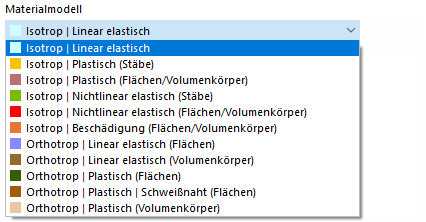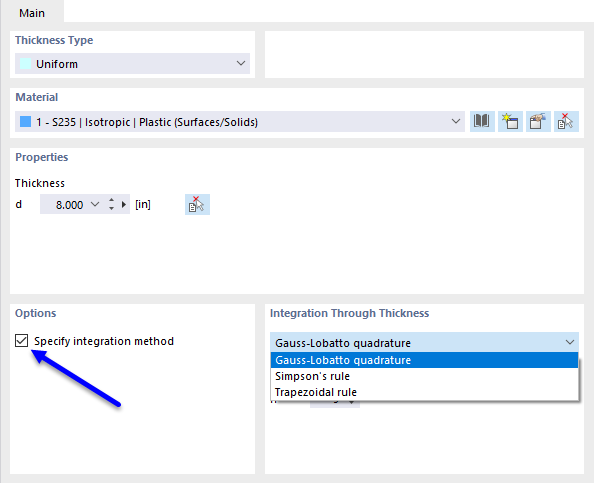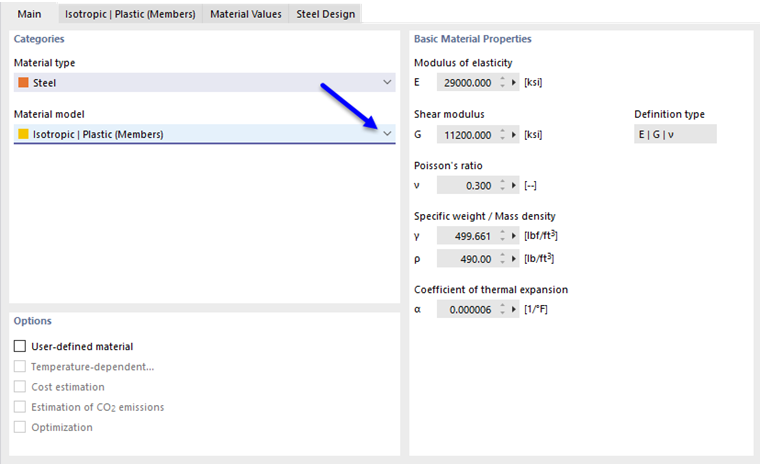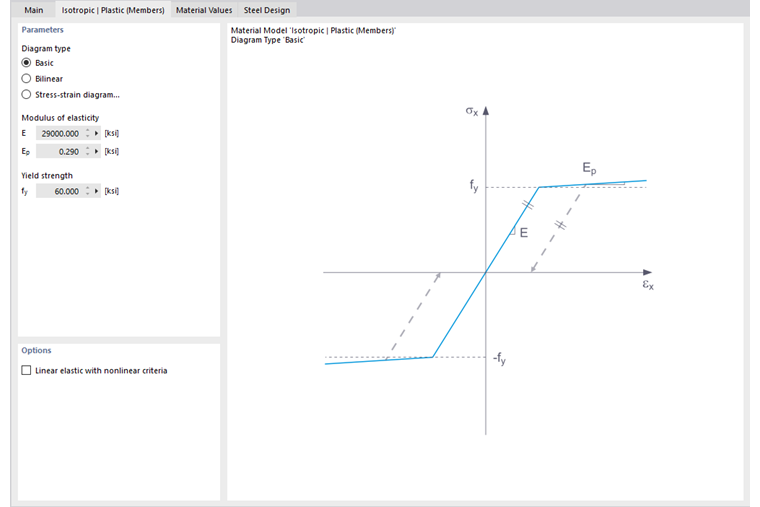Se o módulo de análise Comportamento de material não linear se encontra activado (é necessário uma licença) em Modelo - Dados gerais, existem outras opções para selecção na lista de modelos de material para além da opção 'Isotrópico | Linear elástico' e 'Ortotrópico | Modelos de material linear elástico'.
Se utilizar modelos de material não lineares no RFEM, é sempre realizado um cálculo iterativo. Dependendo do modelo do material, é definida uma relação diferente entre tensões e deformações.
A rigidez dos elementos finitos é ajustada repetidamente no decurso das iterações até que a relação tensão-deformação seja cumprida. O ajustamento é sempre realizado para toda uma superfície ou elemento sólido. Portanto, é recomendado utilizar sempre o tipo de suavização Constante nos elementos da malha ao avaliar tensões.
Alguns modelos de material no RFEM são indicados por 'Plástico', outros por 'Não linear elástico'.
Se um componente estrutural com um material elástico não linear for libertado novamente, a deformação volta pelo mesmo caminho. Se está completamente sem carga, não existe qualquer extensão.
Quando descarrega um componente estrutural com um modelo de material Plástico , a extensão permanece após ter sido completamente descarregado.
Pode encontrar mais informação sobre modelos de material não lineares no artigo técnico que descreve as {%>https://www.dlubal.com/pt/apoio-tecnico-e-formacao/apoio-tecnico/base-de-dados-de-conhecimento/000968 Limites de elasticidade em isotrópicos não lineares elásticos modelo de material.]]
Os esforços internos e os momentos em placas com material não linear resultam da integração numérica das tensões sobre a espessura d da placa. Para definir o método de integração para a espessura, seleccione a opção Especificar método de integração na caixa de diálogo 'Editar espessura'. Estão disponíveis os seguintes métodos de integração:
- Quadratura de Gauss-Lobatto
- Regra de Simpson
- Regra do trapézio
Além do mais, pode especificar o 'Número de pontos de integração' de 3 a 99 através da espessura da chapa.
Isotrópico plástico (barras)
Quando seleciona a linha Isotrópica | Plástico (barras) na lista pendente 'Modelo do material', é activado o separador para a introdução de parâmetros de material não linear.
Neste separador, pode definir o diagrama tensão-deformação. Estão disponíveis as seguintes opções:
- Basic
- Bilinear
- Diagrama tensão-deformação
Se é selecionado Básico ', o RFEM utiliza um modelo de material bilinear. Os valores da base de dados de materiais são utilizados para o módulo de elasticidade E e a tensão de cedência fy Por razões numéricas, a parte do gráfico não é exatamente horizontal, mas tem uma pequena inclinação Ep.
Se pretende alterar os valores para o limite de elasticidade e o módulo de elasticidade, ative a caixa de seleção "Material definido pelo utilizador" no separador 'Geral'.
Para uma definição bilinear , também pode introduzir um valor para Ep.
As relações mais complexas entre tensão e deformação podem ser definidas através do "Diagrama tensão-deformação". Ao selecionar esta opção, o separador 'Diagrama de tensão-deformação' é exibido.
Defina um ponto para a relação tensão-deformação em cada linha da tabela. Pode selecionar como é que o diagrama continua após o último ponto de definição na lista 'Fim do diagrama' por baixo do diagrama:
No caso de 'Rasgamento', a tensão após o último ponto de definição volta a zero. 'Cedência' significa que a tensão permanece constante quando a extensão aumenta. 'Contínuo' significa que o gráfico continua com a inclinação da última secção.
Isotrópico plástico (superfícies/sólidos)
Ao selecionar a linha "Isotrópico | Plástico (superfícies/sólidos)" na lista pendente 'Modelo do material', é activado o separador para a introdução de parâmetros de material não linear.
Wählen Sie zunächst die 'Spannungsversagensagenshypothese' nosso. Zur Auswahl stehen dieses hipóteses:
Primeiro, seleciona a 'Hipótese de falha de tensão'. Estão disponíveis as seguintes hipóteses para seleção:
- von Mises (critério de cedência de von Mises)
- Tresca (critério de cedência de Tresca)
- Drucker-Prager
- Mohr-Coulomb
Se for selecionado "von Mises", é utilizada a seguinte tensão no diagrama tensão-deformação:
Superfícies:
Sólidos:
De acordo com a hipótese de "Tresca", é utilizada a seguinte tensão:
Superfícies:
Sólidos:
De acordo com a hipótese "Drucker-Prager", é utilizada a seguinte tensão para superfícies e sólidos:
|
σc |
Grenzspannung für Druck |
|
σt |
Grenzspannung für Zug |
De acordo com a hipótese de "Mohr-Coulomb", são utilizadas as seguintes tensões para superfícies e sólidos:
Isotrópico elástico não linear (barras)
A funcionalidade corresponde em grande parte à do modelo de material isotrópico plástico (barras). A diferença é que não existe qualquer deformação plástica após o descarregamento.
Isotrópico elástico não linear (superfícies/sólidos)
A funcionalidade corresponde em grande parte à do modelo de material isotrópico plástico (superfícies/sólidos). A diferença é que não existe qualquer deformação plástica após o descarregamento.
Dano isotrópico (superfícies/sólidos)
Em contraste com outros modelos de materiais, o diagrama de tensão-deformação para este modelo de material não é antimétrico à origem. Assim, o comportamento do betão armado com fibra de aço pode ser apresentado com este modelo de material, por exemplo. Encontre informação detalhada sobre a modelação de betão armado com fibra de aço no artigo técnico sobre Determinação das propriedades de material de fibras de aço betão armado.
Neste modelo de material, a rigidez isotrópica é reduzida com um parâmetro de dano escalar. O parâmetro de dano é determinado a partir da curva de tensão definida no diagrama. A direção das tensões principais não é tida em consideração, pelo contrário, os danos ocorrem na direção da deformação equivalente, que também cobre a terceira direção perpendicular ao plano. A área de tração e compressão do tensor de tensão é tratada separadamente. São aplicados diferentes parâmetros de danos em cada caso.
O "Tamanho do elemento de referência" controla como a deformação na área da fenda é escalada em relação ao comprimento do elemento. Com o valor predefinido zero, não é realizado o dimensionamento. Assim, o comportamento de material do betão reforçado com fibras de aço é modelado de forma realista.
Encontra mais informação sobre os fundamentos teóricos do modelo de material 'Dano isotrópico' no artigo técnico que descreve a [https://www.dlubal.com/pt/apoio-tecnico-e-formacao/apoio-tecnico/base-de-dados-de-conhecimento/001461 Dano no modelo de material não linear.
Ortotrópico plástico (superfícies)/ortotrópico plástico (sólidos)
O modelo de material de acordo com "Tsai-Wu" unifica as propriedades plásticas com as ortotrópicas. Isto permite uma modelação especial de materiais com características anisotrópicas, tais como plásticos reforçados com fibras ou madeira.
Se o material é plastificado, as tensões permanecem constantes. A redistribuição é realizada de acordo com as rigidezes disponíveis nas direções individuais.
TIMBER
TIMBER
A área elástica corresponde ao modelo de material Ortotrópico. Para a zona plástica aplica-se a seguinte condição de cedência de acordo com Tsai-Wu:
Superfícies (2D):
FORMEL
Sólidos (3D):
FORMEL
Todas as tensões tem de ser definidas de forma positiva.
A condição de cedência pode ser imaginada como sendo uma superfície elíptica num espaço de tensões de seis dimensões. Se um dos três componentes de tensão for aplicado como um valor constante, é possível uma projeção da superfície num espaço de tensão tridimensional.
Se o valor para fy (σ) de acordo com a equação de Tsai-Wu, a condição de tensão plana é inferior a 1, as tensões estão na zona elástica. A zona plástica é atingida assim que fy (σ) = 1. Não são permitidos valores superiores a 1. O comportamento do modelo é idealmente plástico, o que significa que não existe reforço.












